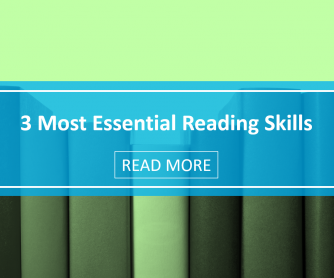Reading is so much more than starting with the first word on the page and moving along each line till you get to the end.
Reading is an essential skill for academic success, and we all know how important it is. We wouldn’t spend the time we do teaching it if we didn’t value reading. Even though reading is so essential, we often overlook the fundamental reading skills that our students need. Reading isn’t just about going from the beginning to the end of a written passage. There are different reading strategies to use for different informational outcomes.
Here are three strategies your students should learn to give them full academic success.
Three Quintessential Reading Strategies
-
1
Scanning
Scanning is used when looking for a specific piece of information in a given text. When a student scans, he looks over the selection quickly to locate the particular piece of information he needs and reads only that information, but carefully. Once he finds this information, he stops reading. The reading passage could be a selection on a test with reading comprehension questions, but it may also simply be reading a schedule to see when a particular movie is playing or checking a weather map in a newspaper. Scanning is a fast form of reading that does not pay attention to every detail given in the text. Before students can scan for the answer to their questions, they should think about what form the answers will take. Will they be a time? Will they be a location? Knowing this beforehand will assist students in locating the information quickly.
-
2
Skimming
Skimming, like scanning, is a quick type of reading. Unlike scanning, though, the goal of skimming is to learn the main points in a larger selection of writing rather than answer one specific question. When you skim milk, you take the richest part off the top. Likewise, when your students skim a reading passage, they should be pulling all the most essential information out of a piece. The most straightforward way to skim a given passage is to read the entire first paragraph, the entire last paragraph and read the first sentence of each additional paragraph in between. In so doing, your students should be able to identify the major themes throughout the passage. Students should also pay attention to italicized or bold words, headings and subheadings. After skimming a passage, students can then decide whether to go back and read the entire selection or to scan for particular information. Skimming can be a difficult activity for ESL students as they often get bogged down by new vocabulary and confusing grammar. Reassure your students that when they skim a passage, they only need to get the author’s primary points. Encourage them to guess at any new vocabulary they come across and not to worry about the details.
-
3
Reading for Detail
Careful reading or reading for detail is probably the most commonly used reading strategy. This is a slower reading process that starts at the beginning of a passage and proceeds to the end. When reading for detail, students should read every sentence, but they should not try to know the exact meaning of each word. Even native speakers infer the meaning of unknown words as they read. Reassure your students that even when reading for information, they do not need to know every word on the page but should try and guess its meaning from the context, a valuable skill in and of itself. If students put too much pressure on themselves when it comes to new vocabulary, the dictionary may become more of a burden than a blessing. When reading for detail, students should aim to understand about eighty percent of the information they read. If they need an answer to a particular question that they may have missed, they can always go back and scan for it.
Reading may sometimes seem as easy as a, b, c, but in fact there are strategic ways to make your students’ reading more useful and productive. By teaching skimming and scanning in addition to reading for detail, you will give your students the strategies they need to be successful learners.
P.S. If you enjoyed this article, please help spread it by clicking one of those sharing buttons below. And if you are interested in more, you should follow our Facebook page where we share more about creative, non-boring ways to teach English.








